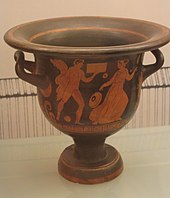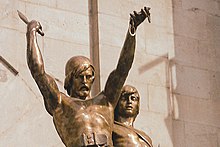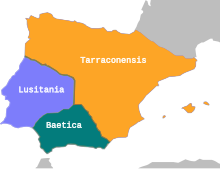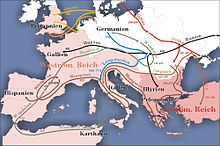History of Catalonia
The history of Catalonia goes back to the year 1000 BC. BC when the Iberians settled the Pyrenees Peninsula. Before the colonization by Cro-Magnon people (Homo sapiens) , the region was already inhabited by Neanderthals , as is shown by finds in the Cova Gran de Santa Linya cave . In historical times Catalonia was originally settled by Iberians , later the coastal area was under the influence of Carthage . End of the 3rd century BC Rome gained dominance; the Romans raised the area to the province of Hispania Tarraconensis in 19 AD . As early as the 1st century AD, Christianity gained a foothold in what is now Catalonia.
Early history and pre-Roman times
The Phoenicians and Greeks
The first written evidence of what is now Catalonia comes from the time when the Phoenicians and Greeks - both from the eastern Mediterranean - reached the Iberian Peninsula . In the 8th century BC The Phoenicians had already settled in several places in the south of the peninsula. In the centuries that followed, the Phoenician colonies were taken over by Carthage , a powerful city of Phoenician origin in North Africa. The Carthaginians turned northeast along the coast to prevent the Greeks from spreading south. In Ibusim ( Eivissa, Ibiza ), they founded an important colony that existed for a long time.
The Greeks reached the peninsula a short time after the Phoenicians. However, trade did not develop until the 6th century BC. Under the Ionians , the founders of the city of Massalia ( Marseilles ). On the coast of today's Catalonia they founded between 750 BC. BC and 550 BC B.C. including Emporion ( Empúries ) as the most important trading post. The first settlement arose on a small island in the Bay of Roses - but the rapid growth and trade with the local population soon forced a relocation to the mainland. The Rhode ( Roses ) branch was established a few kilometers from Emporion . The settlers of Emporion developed agriculture and trade; Silver coins were minted in both Emporion and Rhode . A special ceramic was also produced, which was widely used.
The Iberians
The 5th and 4th centuries BC After many battles , Celts who immigrated from Gaul merged with the native Iberians to form the Celtiberians . They invaded the south and east coast of the peninsula. North of the Ebro , the Iberian peoples had some cultural similarities, such as language and writing, mastery of iron processing , pottery and agriculture as a basis. The social structure was formed by the individual tribes. The already urban settlements were built on hills to facilitate defense.
In the territory of the present province of Barcelona the left Laietans down. The most important cities were Barcino, the origin of today's Barcelona , Baetulo ( Badalona ), Egara ( Terrassa ) and Blanda ( Blanes ). North of Laietans and in the territory of the present province of Tarragona lived Indigetes . Their main settlement was near Ullastret in the province of Girona . But the most powerful Iberian people were the Ilergetes . Their settlement area lay between the valleys of the Cinca and the Segre and the capital cities were Iltirda ( Lleida ) and Atanagrum (the exact location is no longer known). Under their king Indibil , the Ilergetes took part in the wars between the Roman Empire and the Carthaginians. The strategic location of their settlement area enabled changing alliances with Rome or (mostly) Carthage. With the Roman victory against Carthage in the Second Punic War , the Iberians were gradually incorporated into the Roman Empire.
Roman time
After the First Punic War 264 to 241 BC The Carthaginians ruled the entire Mediterranean coast of the Iberian Peninsula . Their siege of Sagunto and with it the breach of the Ebro Treaty of 226 BC Between Rome and Hasdrubal led 218 BC. For the landing of two Roman legions in Emporion ( Empúries ) and thus at the beginning of the Second Punic War until 201 BC. Then the Romans conquered the country.
Roman conquest
218 BC Chr. Gnaeus Cornelius Scipio Calvus landed in Emporion to block the Carthaginian Hannibal 's way to Italy . During the Second Punic War , both the Romans and the Carthaginians tried to win the Iberian peoples on their side. From Tarraco ( Tarragona ), the Roman troops soon controlled the entire coast of what is now Catalonia. Under Scipio the Elder , the Romans invaded in 209 BC. BC to southern Spain. After this recognizable superiority of the Romans, numerous leaders of the Iberian tribes took the side of the Romans. Nevertheless, the new masters still had to put down a revolt of the Ilergetes under the leadership of Indibil and Mandoni . 206 BC The last Carthaginian general was expelled from the peninsula and four years later, at the end of the war, the entire Mediterranean coast of Spain was under Roman rule. The conquered peoples were obliged to pay tribute , and the mines became the property of the Roman Empire .
The part of the peninsula controlled by the Romans after the Celtiberian War (197 BC to 179 BC) was divided into two provinces: Hispania citerior in the northeast, Hispania ulterior in the southwest. In the following time there were still some uprisings, which only began in 133 BC. Could finally be crushed. The last century BC was marked by internal political conflicts between the Romans in Italy, which also took place on the Iberian Peninsula. In the years 80 to 70 BC The area of today's Catalonia was the last scene in the war between the followers of Marius and Sulla ; the Marian Sertorius , who had fled from Sulla, organized one last major resistance movement against Rome, which was only finally defeated after his assassination. In the following Roman civil war from 49 BC Gaius Iulius Caesar won the decisive victory against Pompey at Ilerda ( Lleida ). This victory opened a period of almost three hundred years of peace, which allowed the spread of Roman culture.

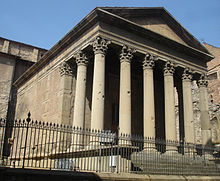

Romanization
After Hispania was conquered and pacified, the Romans established their political, administrative, social and economic organization. The Vulgar Latin replaced the Iberian languages and it was the imperial cult introduced. The Roman law introduced at the same time was to have a strong influence for a long time. In the countryside, the land was expropriated and distributed to Roman settlers, veterans, and local allies. Private latifundia (country estates) were created that were managed with slave labor . The rich owners lived mostly in the cities and left the work to the administrators. These introduced new techniques for rearing and irrigation. The first country estates ( villae rusticae ) in Catalonia were built in the second century BC in the hinterland of today's Barcelona and in Camp de Tarragona . They experienced their greatest distribution under Augustus . On the Catalan coast, wine was mainly grown and sold, which in turn required the manufacture and sale of amphorae .
Since Caesar and especially under Augustus, the numerous streets and forts led to a rapid Romanization of the country, which soon became a center of Roman culture. At the same time, the construction of the road network and the use of a single currency allowed trade to expand and the population grew rapidly. The Romans introduced important innovations in the organization of the likewise rapidly growing cities, which developed into production, trade and administrative centers. This can be seen in the numerous public buildings of the time such as forums , theaters and amphitheatres , circus arenas and basilicas (as in Tarragona), temples (as in Vic ), thermal baths (such as those of Caldes de Montbui ), aqueducts and bridges (as in Tarragona the Aqüeducte de les Ferreres and in Martorell ) etc.
The main axis of the Roman road network was the Via Augusta , which followed the Mediterranean coast from Carthago Nova ( Cartagena ) and reached the Ebro via Valencia at Dertosa ( Tortosa ). After Tarraco was crossed, she turned on the eastern outskirts at the Arc de Berà later called the honor arch to the inland to Martorell , where the bridge of that time is still preserved today. Then it led back to the coast at Barcino and followed it to Gerunda ( Girona ). From then on, she turned the Pyrenees, reaching at La Jonquera the Gallic province Narbonensis .en
Development in the Imperial Era
In the years 27 to 25 BC A reorganization of the provinces took place by Augustus. Hispania Citerior became the Imperial Province of Hispania Tarraconensis, which stretched from the Catalan coast along the Ebro to present-day Galicia . The capital of this province became the rich colony of Tarraco , which already extended over 70 hectares and had numerous monumental structures. 27 BC The construction of a temple in honor of Augustus and Jupiter is proven there. During this time, the Roman Barcino ( Barcelona ) emerged and merited war veterans were settled in Empúries.
In 1960 , under Nero's rule , Galba became governor of the province. He joined 68 the rebellion of Gaius Julius Vindex and settled for Emperor exclaim. The dethroned emperor Nero then committed suicide.
With the Constitutio Antoniniana issued by Emperor Caracalla in 212, all free residents of the Roman Empire received Roman citizenship . An almost undisturbed flowering period of development and upswing followed in Tarraconensis until the end of the century. The emerging Christianity was fought under the emperors Decius and Valerianus and so Fructuosus , the bishop of the recently founded diocese of Tarraco, died as a martyr . The deacons Augurius and Eulogius suffered the same fate . Nevertheless, Christianity spread increasingly until it was legitimized in 313 under Emperor Constantine I with the Edict of Tolerance of Milan and subsequently became the predominant religion in the Roman Empire. The political and economic crisis into which the Roman Empire fell from the 3rd century onwards also had irreversible consequences for the province of Tarraconensis and the capital Tarraco.
Migration of peoples and end of Roman rule
At the beginning of the 3rd century, a period of decline began in the Roman Empire, known as the Imperial Crisis . Changing takeovers of power by various emperors led to revolts in the provinces, which were additionally weakened by invasions of Germanic tribes. The system of slavery had long ago proven unsuitable for an expanding economy, as the Romans hardly conquered new territories and fewer and fewer slaves entered the market.
In what is now Catalonia, the cities of Tarraco and Emporion in particular suffered from the invasions and could no longer recover from them. Gerunda and Barcino then built city walls. Trade with Rome weakened and the economic crisis and uncertainty forced many families to flee to the country. There, in turn, the fear of attacks resulted in the number of small and medium-sized estates falling. Large domains emerged on which the labor of slaves was replaced by small farmers, to whom the large landowners left the land for a temporary lease .
The reforms of the Emperors Diocletian and Constantine the Great from the end of the 3rd century allowed a certain stability for some time. The Tarraconensis was divided into four provinces: Insulae Baleares , Gallaecia , Carthaginiensis and Tarraconensis, the last again including the area of today's Catalonia. Alans , Suebi and Vandals invaded the country around 409 and established various short-lived independent states. In the course of the Roman campaign against the invaders, the Visigoths moved into the Tarraconensis from their settlement area in Aquitaine until 415 as federates of the Roman Empire . Under their King Athaulf , they first settled near Barcino (Barcelona). In 429, the Vandals and Alans moved on to North Africa and the Suebi gained dominance on the peninsula, except in the Tarraconensis. In 449 they advanced as far as Lleida with the support of the Bagauden .
Euric , king of the Visigoths, conquered Tarraco in 475 and completely destroyed it. The political and social structures of the Hispanic provinces gradually dissolved and with the fall of the Western Roman Empire in 476, the Visigoth Empire , which already included today's Catalonia, became independent.
The Visigoth Empire
In the course of the process of dissolution of the Imperium Romanum, the Visigoths came to Spain for the first time in 418, entrusted with police duties, but they did not establish themselves on the Iberian Peninsula until after the Battle of Vouillé in 507. The legacy of this Visigothic empire was most tenacious on the southern slopes of the Pyrenees . The Gothic legal code Liber Iudicum from 654 remained in use until the 11th century - even the inclusion of the southern Pyrenees region in the Franconian trademark system ( Spanish mark ) did not change anything. However, maintaining local independence was not synonymous with cultural isolation . The Pyrenees region has always been a preferred passage area for culture and trade between the Middle East and the British Isles .

The Gothic conquest of Catalonia began in the 5th century. However, after the Battle of Vouillé in 507, in which the advancing Franks defeated the Visigoths decisively, the vanquished had to vacate most of their Gallic sphere of influence. In the period that followed, the Visigoths were limited to the Iberian Peninsula and Septimania (a narrow but valuable strip of the Mediterranean coast northeast of the Pyrenees). Toledo became the capital of the new Visigothic Empire ; hence the historians call it the Toledan Empire .
The novels living under Visigothic rule , who, as Catholics, rejected the Arianism of the Visigoths, were initially in a particularly religiously motivated opposition. It was not until the Visigoths converted to Catholicism under King Rekkared I in 589 that these tensions could be resolved. From then on, the Romans and Goths lived relatively peacefully side by side. The Visigoth Empire experienced a heyday at the turn of the 6th and 7th centuries. The basis for this was in particular the Codex Euricianus , which came into force around 475 , a Germanic legal codification that regulated the coexistence of Visigoths, Romans and Celtiberians .
When the Franks invaded Catalonia, the Romansh elite fought on the side of the Goths. They had found a common identity. In the second half of the 7th century, turmoil among the Goths repeatedly gave rise to civil wars, some of which were fought with extreme severity. The kingship was already permanently weakened.
Moorish rule
In the spring of 711 the invasion of the Muslim Moors ( Arabs and Berbers from the region of today's Morocco ) began, who conquered the Iberian Peninsula in a few years. They defeated the army of the weakened Visigoth king Roderich (Rodrigo) and followed the Roman roads on their subsequent campaigns of conquest . After the conquest of Saragossa, the troops turned to what is now Catalonia.
The conquest of Catalonia by the Moors
Tarragona was destroyed and depopulated as early as 714. The actual occupation was slower, however, as the first Muslim settlers were nomads who did not finally settle until the middle of the 9th century. Within a short time the Moors succeeded in completely conquering the earlier Tarraconensis . Some places were subjugated militarily, but most of them signed declarations of submission on their own initiative. Since the residents were able to maintain their way of life and religion, Muslims , Jews and Christians lived side by side in the Moorish-ruled Catalonia . To secure their rule over the places, the Moors stationed troops and levied taxes.
After Abd ar-Rahman I rose to the rank of Emir of Córdoba and threatened to overthrow the governor of Saragossa , he asked Charlemagne for support. In the spring of 778 he then marched with an army via Pamplona to Saragossa, another army moved (initially unsuccessfully) to Barcelona . In 785, the Franks finally conquered Girona without encountering much resistance. In the following time, shorter expeditions of conquest and forays alternated on both sides of the Pyrenees. The Arabs took Narbonne in 795 , in 801 the Franks again conquered Barcelona and founded the Spanish Mark in 806 . As a result, the Frankish rule was also able to consolidate south of the Pyrenees . The Balearic Islands had also been fought over between the Moors and Franks since 798.
During the time of the Caliphate of Cordoba in the 10th century, the northern border stabilized against the Frankish-ruled counties. Lleida and Tortosa, the two main cities, were the centers of defense. Many of the predominantly Christian residents of these Moorish border regions converted to Islam. In particular, the inhabitants of the Ebro , Segre and Cinca valleys and the Lleida plain adopted the Moors' way of life and achievements, such as highly developed irrigation technology. The most important Moorish cities in Catalonia were Lleida, Balaguer and Tortosa . These cities developed an old town (medina) in the North African style with a mosque , administrative center and court. They also had large markets ( souks ) with workshops and craftsmen's homes. In some cities there were open places of prayer ( musallā ) and - as in Tortosa - a military fortress. Wood and galena were exported through the port of Tortosa . Although there were peace treaties between the caliph in Cordoba and some Catalan counts, the mutual attacks increased. In 985 Almansor plundered Barcelona and captured several thousand residents.
The fall of Moorish rule in Catalonia
From the beginning of the 11th century, internal power struggles led to the decline of the Caliphate of Córdoba. After the death of the last caliph Hisham III. began the time of the Taifa kingdoms in 1031 . The Muslim minor kingdoms along the Mediterranean coast were ruled by supporters and relatives of Almansor.
The Catalan counties were bordered by the Taifas of Saragossa, Lleida and Tortosa. In these the local nobility ruled and the Catalan counts bought a peaceful coexistence by paying taxes. When Raimund Berengar I (1023-1076), the Counts of Barcelona, made their first attempts to occupy the city of Tarragona , the Moors were forced to retreat to safe fortresses in the mountains. The strategic location of these fortresses, particularly of Siurana , delayed the advance of Christian conquerors for a long time. Tarragona was already in 1118 by Raimund Berengar III. (1082–1131) conquered, but a permanent occupation of the region did not take place until 1146. In the years 1148 and 1149 Tortosa and Lleida were conquered and in 1151 the Christian conquerors had encircled the Waliat (= viceroyalty) Siurana. In 1153 it was the last to be recaptured in Catalonia by the troops of Raimund Berengars IV (1113–1162).
The conquered territories were distributed among the nobility and the church and the Moorish population expelled. Tortosa and Lleida retained their great importance and became independent margravates within the county of Barcelona. The monks of the new order of the Cistercians settled in the Camp de Tarragona and founded the monasteries of Poblet and Santes Creus .
Northern Catalonia
In the course of the armed conflicts between the Frankish Empire and the Arabs , the Spanish Mark , which belonged to the Carolingian Empire and consisted of several counties, some of whose names still exist today, was created at the end of the 8th and beginning of the 9th century in the northern part of today's Catalonia and northern Catalonia to be used. In the following period, however, it was possible to break the dependency on the franc . Count Wilfried the Hairy (Catalan Guifré el Pilós; † August 11, 897) united the counties of Urgell , Cerdanya , Barcelona and Girona under his rule and founded the dynasty of the Counts of Barcelona. At the end of the 10th century, the Catalan counties broke away from the feudal rule of the West Frankish king. In addition to these political leaders, the spiritual leader Abbot Oliva , who, among other things, headed the cultural center of Catalonia at that time, the Abbey of Ripoll , is of great importance.
Through the marriage contract between Raimund Berengar IV. , Count of Barcelona, and the only one-year-old Petronila / Peronella, heir to the Crown of Aragon , a state community emerged in 1137 from Aragon and the lands of the Counts of Barcelona, which were largely identical to Catalonia in the 12th century Crown of Aragon is known. Through further dynastic connections and conquests, it became the leading power of the western Mediterranean in the High and Late Middle Ages . Its economic and cultural center was the Catalan part of the state community, the Principate of Catalonia , whose merchant fleet ruled the western Mediterranean.
15th to 18th century
In 1469 Ferdinand , heir to the lands of the Crown of Aragon, and Isabella , heir to the lands of the Crown of Castile, married . They went down in history as the Catholic Kings (Los Reyes Católicos) . After the two had taken over the government in Castile in 1474 and Ferdinand in 1479 also in the countries of the Crown of Aragon, the countries were ruled in a personal union until 1504 . The internal political independence of Catalonia was retained. The personal union was re-established under similar conditions after Charles I became king in 1516.
In the Franco-Spanish War of 1635-1659 there were separatist movements in Spain. In 1640 Portugal successfully regained its independence (after the death of the last Portuguese king from the House of Avis in 1580, it was ruled in personal union with Spain). Catalonia and Aragón also tried to regain independence, but were unsuccessful. In the Peace of the Pyrenees , Spain had to cede the Catalan areas north of the Pyrenees (the historic county of Rosselló or Roussillon, Northern Catalonia ) to France, the rest of Catalonia remained with Spain.
In the War of the Spanish Succession (1700–1713), in which it was a question of the succession to the throne after the death of the childless Charles II of Spain , Catalonia supported the Habsburg pretender Archduke Charles against the Bourbon Philip of Anjou. Philip V , who emerged victorious in the Peace of Utrecht, punished Catalonia harshly for this: in 1714, besieged Barcelona surrendered to Philip's troops, in the following years the Catalan institutions were dissolved in the course of the Decretos de Nueva Planta , whereby the Catalan self-government ended. To commemorate this event, September 11th, the day of the surrender in 1714, is celebrated today as the Catalan "national holiday" - Diada Nacional de Catalunya .
Napoleon's time
From 1812 to 1814, Catalonia was part of the French Empire and was first divided into four and later into two French departments .
20th century
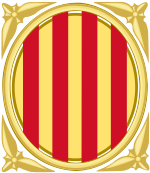

In the Second Republic , Catalonia was granted provisional autonomy in 1931 with the re-establishment of the Generalitat ; this was enshrined in the 1932 Statute of Autonomy. However, from 1934 to 1936 the autonomy was suspended and was abolished with the victory of Francisco Franco in the Spanish Civil War in 1939. During the civil war of 1936–1939, Catalonia (especially Barcelona) was the scene of the only (at least temporarily) successful anarchist revolution in European history.
The Generalitat continued to exist in exile during the Franco dictatorship . In the course of the transition that began after Franco's death, the Generalitat de Catalunya, which had limited powers, was provisionally restored in 1977 . The then President of the Generalitat, Josep Tarradellas , was allowed to return to Barcelona from exile and formed a new unity government there. On the basis of the democratic Spanish constitution of 1978, Catalonia received a new statute of autonomy in 1979 . In this context, the competencies and the financing of the region were continuously expanded, mostly due to pressure from the national-Catalan groups.
Politics in Catalonia has been shaped since 1980 by the Christian Democratic-National Catalan party alliance Convergència i Unió (CiU) under its chairman Jordi Pujol . From 1980 to 2006, CiU achieved four relative and three absolute majorities in elections and, with Pujol, was the head of government of Catalonia without interruption until 2003 (Catalan: President de la Generalitat ).
21st century
From 2003 to 2011 Catalonia was ruled by the socialists ( PSC ) in a coalition with two other left-wing parties . The President of the Generalitat was Pasqual Maragall from 2003 to 2006 and José Montilla (both PSC) from 2006 to 2010 . In 2006, Catalonia received a new statute of autonomy with expanded powers, which in 2010 was declared partially unconstitutional by the Spanish Constitutional Court .
Since 2010, politics in Catalonia has been increasingly determined by the discussion about state independence ; to found referenda and plebiscite instead. Catalan society is considered to be deeply divided on the issue. Since the 2015 parliamentary elections , Catalonia has been ruled by a separatist government coalition. After a controversial independence referendum on October 1, 2017, which was declared unconstitutional by the Spanish Constitutional Court and which triggered the Catalonia crisis , the regional government under Carles Puigdemont declared independence on October 27, 2017, but was ousted by the central government on the same day . The Spanish judiciary has initiated criminal proceedings against several separatist politicians since 2017 .
See also
literature
- Walther L. Bernecker , Torsten Esser, Peter A. Kraus : A little history of Catalonia. Suhrkamp, Frankfurt 2007, ISBN 978-3-518-45879-2 .
- Carlos Collado Seidel : Brief history of Catalonia. CH Beck, Munich 2007, ISBN 978-3-406-54787-4 .
- Andreu Varela, Gine Albadalejo, Antoni Bons, Lluís Poudevila, Joan Ramón Varela: Història de Catalunya. Columna, Barcelona 1991, ISBN 84-7809-075-4 .
- Montserrat Llorens, Rosa Ortega, Joan Roig: Història de Catalunya . Vicens Vives, Barcelona 1993, ISBN 84-316-2624-0 .
Web links
- Museu d'Història de Catalunya (Catalan, Spanish, English)
Individual evidence
- ↑ Birgit Aschmann : The Catalan problem . In: Frankfurter Allgemeine Zeitung of December 18, 2017, p. 6.
- ^ Paul Ingendaay : The divided society. In: Frankfurter Allgemeine Zeitung , October 9, 2015.

